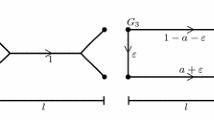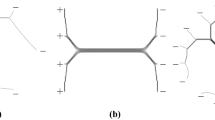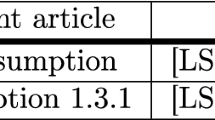Abstract
The transportation problem can be formalized as the problem of finding the optimal paths to transport a measure μ + onto a measure μ − with the same mass. In contrast with the Monge–Kantorovich formalization, recent approaches model the branched structure of such supply networks by an energy functional whose essential feature is to favor wide roads. Given a flow s in a road or a tube or a wire, the transportation cost per unit length is supposed to be proportional to s α with 0 < α < 1. For the Monge–Kantorovich energy α = 1 so that it is equivalent to have two roads with flow 1/2 or a larger one with flow 1. If instead 0 < α < 1, a road with flow \(s_1+s_2\) is preferable to two individual roads s 1 and s 2 because \((s_1+s_2)^\alpha < s_1^\alpha+s_2^\alpha\) . Thus, this very simple model intuitively leads to branched transportation structures. Such a branched structure is observable in ground transportation networks, in draining and irrigation systems, in electric power supply systems and in natural objects like the blood vessels or the trees. When \(\alpha > 1-\frac 1N\) such structures can irrigate a whole bounded open set of \({\mathbb{R}}^N\) . The aim of this paper is to give a mathematical proof of several structure and regularity properties empirically observed in transportation networks. It is first proven that optimal transportation networks have a tree structure and can be monotonically approximated by finite graphs. An interior regularity result is then proven according to which an optimal network is a finite graph away from the irrigated measure. It is also proven that the branching number of optimal networks has everywhere a universal explicit bound. These results answer questions raised in two recent papers by Xia.
Similar content being viewed by others
References
Bernot, M.: Irrigation and Optimal Transport. Ph.D. Thesis, École Normale Supérieure de Cachan (2005). http://tel.archives-ouvertes.fr/tel-00132078
Bernot M., Caselles V. and Morel J.-M. (2005). Traffic Plans. Publicacions Matemàtiques 49: 417–451
Bernot M., Caselles V. and Morel J.-M. (2006). Are there infinite irrigation trees? J. Math. Fluid Mech. 8: 311–332
Bhashkaran S. and Salzborn F.J.M. (1979). Optimal design of gas pipeline networks. J. Oper. Res. Soc. 30: 1047–1060
Brenier Y. (1993). The dual least action problem for an ideal, incompressible fluid. Arch. Rational Mech. Anal. 122: 323–351
Buttazzo G., Pratelli A. and Stepanov E. (2006). Optimal pricing policies for public transportation networks. SIAM J. Opt. 16: 826–853
Buttazzo, G., Pratelli, A., Solimini, S., Stepanov, E.: Optimal urban networks via mass transportation. Preprint (2007), available at http://cvgmt.sns.it/cgi/get.cgi/papers/butprasol07/
Caselles, V., Morel, J.-M.: Irrigation. In: Tomarelli, F., Dal Maso, G. (eds.) Progress in Nonlinear Differential Equations and their Applications, vol. 51, pp. 81–90, Birkhaser (2002). VARMET 2001. Trieste, June, 2001
De Villanova, G.: Singular Structures in some Variational Problems. Ph.D. Thesis, École Normale Supérieure de Cachan (2005)
Devillanova G. and Solimini S. (2007). On the dimension of an irrigable measure. Rendiconti del Seminario Matematico della Universitá di Padova 117: 1–49
Devillanova G. and Solimini S. (2007). Elementary properties of optimal irrigation patterns. Calc. Var. Partial Differential Equations 28: 317–349
Dudley R.M. (2002). Real Analysis and Probability. Cambridge University Press, Cambridge
Gilbert E.N. (1967). Minimum cost communication networks. Bell Syst. Tech. J. 46: 2209–2227
Kantorovich L. (1942). On the transfer of masses. Dokl. Acad. Nauk. USSR 37: 7–8
Lee D.H. (1976). Low cost drainage networks. Networks 6: 351–371
Maddalena F., Solimini S. and Morel J.M. (2003). A variational model of irrigation patterns. Interfaces Free Bound. 5: 391–416
Maddalena, F., Solimini, S.: Transport distances and irrigation models. Preprint (2007), available at http://cvgmt.sns.it/papers/madsol07/
Mauroy B., Filoche M., Weibel E. and Sapoval B. (2004). An optimal bronchial tree may be dangerous. Nature 427: 633–636
Monge, G.: Mémoire sur la théorie des déblais et de remblais. Histoire de l’Académie Royale des Sciences de Paris, pp. 666–704 (1781)
Paolini E. and Stepanov E. (2006). Optimal transportation networks as flat chains. Interfaces Free Bound. 8: 393–436
Xia Q. (2003). Optimal paths related to transport problems. Commun. Contemp. Math. 5: 251–279
Xia Q. (2004). Interior regularity of optimal transport paths. Calculus Variations Partial Differen. Equat. 20: 283–299
Xia, Q.: Boundary regularity of optimal transport paths. Preprint (2005), available at http://www.ma.utexas.edu/users/qlxia/
Xia Q. (2007). The formation of a tree leaf ESAIM Control Optim. Calc. Var. 13: 359–377
Xue G., Lillys T. and Dougherty D. (2000). Computing the minimum cost pipe network interconnecting one sink and many sources. SIAM J. Optim. 10: 22–42
Zhang J.Z. and Zhu D.T. (1996). A bilevel programming method for pipe network optimization. SIAM J. Optim. 6: 838–857
Author information
Authors and Affiliations
Corresponding author
Rights and permissions
About this article
Cite this article
Bernot, M., Caselles, V. & Morel, JM. The structure of branched transportation networks. Calc. Var. 32, 279–317 (2008). https://doi.org/10.1007/s00526-007-0139-0
Received:
Accepted:
Published:
Issue Date:
DOI: https://doi.org/10.1007/s00526-007-0139-0




